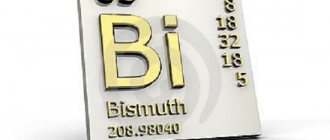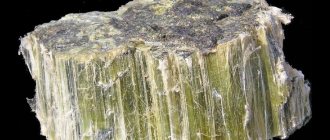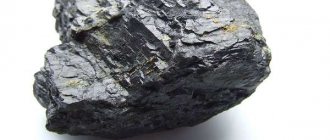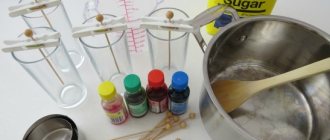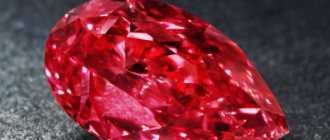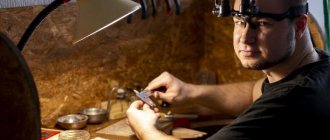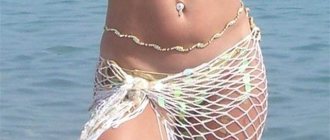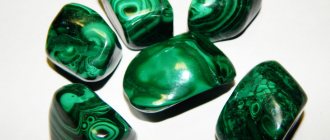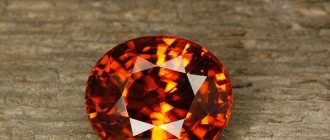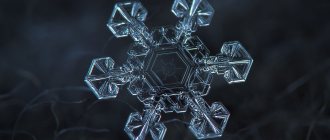Bismuth as a metal has been known since ancient times. Alchemists mentioned it in their books back in the 15th century, endowing the native mineral with magical properties. Scientists believed in the power of bismuth to cleanse the human aura and charge it with positive energy. The beauty of its crystals is mesmerizing. Using the element in mysterious magical actions promises a person a change in his spirit for the better.
Form of being in nature
The appearance of crystals . Crystals of the mineral bismuth are very rare; rhombohedral, pseudocubic. Cubic. Dendrites (skeletal crystals).
Twins according to (1012), often polysynthetic; may occur when exposed to pressure.
Aggregates. In the form of individual grains, sometimes in large secretions (leafy, granular), feathery dendrites. Extremely rare in crystals. In some deposits, the weight of continuous deposits of native bismuth reaches 22 kg.
Interesting Facts
- When there was an oil spill in the Gulf of Mexico, seabirds were fed bismuth. This was done in order to remove oil from the birds’ bodies.
- In the very first years after the discovery of the metal, it was often confused with tin and antimony.
- Bismuth is element 83 in the periodic table.
- Bismuth alloys have found widespread use in the industrial sector. The most famous is Wood's alloy. Once, with his help, a comedian made a teaspoon. There were practically no differences from the usual one. But in hot water, the alloy spoon simply dripped to the bottom.
Physical properties
Optical
- Color. Reddish, silver-white, usually with mottled, green or red tarnish. When freshly fractured, it is silvery-white with a yellowish tint; over time, a reddish tarnish appears.
- The streak is light gray, silver-white, shiny.
- Metallic shine.
- Low tide - tarnish
- Transparency. Opaque.
Mechanical
- Hardness 2—2.5; easy to cut.
- It is fragile, but when carefully handled with a hammer, it sometimes flattens. On planes (0001) gives impact figures with rays located at an angle of 60°
- Density 9.78-9.83.
- Cleavage according to (0001) is perfect, according to (2021) good; separate by (1012).
- Kink. grainy.
Chemical properties
Easily dissolves in HNO3 after dilution, a white precipitate forms; It is more difficult to dissolve in HCl. It is poisoned by HNO3 (slowly boils and turns brown), HCl (slowly turns brown), FeCl3 (turns brown, iridescent, structure is revealed), HgCl2 (turns brown).
Other properties
Diamagnetic Melts at 271.3°. The mineral is rough to the touch.
Bismuth in medicine
The mineral has been used by official medicine for a long time; its healing qualities are not a myth or fiction, but a reality, verified by numerous experiences and facts. It is part of many medications - tablets, powders, emulsions, ointments, gels. It gives cosmetics - lipsticks, mascara and varnishes a pleasant, beautiful shine and prolongs their shelf life.
Bismuth is used as an antitumor agent. The antiseptic and astringent properties of the mineral are used to stop inflammatory processes in the gastrointestinal tract, treat ulcers and gastritis, relieve severe pain and colic in the stomach and intestines, and eliminate constipation.
Products for external use with bismuth heal wounds from burns and cuts well.
It is difficult to be poisoned by bismuth, although it is a heavy and toxic metal. And yet, drugs with it must be used as prescribed by a doctor, under his supervision, and for a short period of time.
If too much bismuth accumulates in the body, a person begins to experience arrhythmia, insomnia, tooth enamel darkens, laryngitis and pharyngitis develop, and memory deteriorates. If these symptoms appear, stop using bismuth-containing drugs. In case of strong ingestion, the stomach is washed out.
Artificial production of mineral
It is obtained by electrolysis from solutions (usually imperfect crystals) and from melts (the best crystals).
Diagnostic signs
Similar minerals. Nikelin.
Recognized by a faint yellowish-reddish tint of tarnish, strong metallic luster, perfect cleavage, low hardness and relatively high density. In polished sections in reflected light it looks like native silver, antimony, copper, gold, dyscrazite, algodonite, melonite. It differs from the indicated minerals in lower hardness. Copper, unlike native bismuth, has a characteristic bright pink color. The decisive features that distinguish native bismuth from silver, gold, etc. are: belonging to the 1st group in terms of relative relief in thin section, distinct anisotropy, cleavage, twinning structure, rapid darkening in air (absence of mottled tarnish characteristic of silver).
Associated minerals. Bismuth luster, arsenopyrite, wolframite, topaz, etc.
Properties and description of the mineral
Medieval scientists and alchemists claimed that bismuth was half silver, but in fact it contains the least amount of silver, and its properties are not silver at all.
Bismuth is much weaker than silver in many respects, but it is also highly susceptible to magnetic fields. Native bismuth is influenced by simple water; when it gets on the surface of bismuth, a beautiful rainbow film is formed on it - bismuth oxide.
The film appears on both natural and artificial crystals. People have learned to grow bismuth crystals with unusual geometric shapes that resemble microcircuits of modern electronic equipment, pyramids and other fantastic objects and structures. Artificial crystals vary in color and shape, but they have a common property - they are all incredibly beautiful and unusual.
Bismuth of natural origin, or native bismuth, looks much more modest:
It contains a number of chemical elements - tellurium, arsenic, iron, antimony, astatine, sulfur. This is a combination of seemingly incompatible substances.
The structure of natural bismuth crystals is pseudo-cubic. The structure contains skeletal crystals in the form of flattened lattices. The aggregates are granular and dense.
The color is silver with a pink or reddish tint and variegated streaks. The crystals are opaque and have a metallic luster. Hardness on the Mohs scale is only 2 points.
The mineral is easy to process and can be cut with a regular knife. It melts easily, a melting point of 271 degrees can be easily created using a regular electric stove. Quickly dissolves in nitric acid.
Bismuth crystals can be made at home from material purchased at the store for chemical experiments:
Place of Birth
In pegmatites it very rarely forms large accumulations and is associated with quartz, feldspars, tourmaline, beryl, fluorite, topaz, muscovite, lepidolite and other minerals of pegmatite veins (Emerald mines in the Sverdlovsk region, the northern part of Karelia, Sherlova Gora and Adun-Chilon in Chita region; South Africa; Madagascar; Queensland in Australia, etc.). It is observed in tungsten, molybdenum, tin-arsenic and lead-zinc ores confined to skarns (Lyangar sheelite-molybdenum deposit in Uzbekistan and deposits of the Zeravshan-Gissar mountain region in Tajikistan). In high-temperature tin, tungsten and molybdenum vein deposits, native bismuth is observed together with cassiterite, wolframite, molybdenite, bismuthine, chalcopyrite and other minerals (Akchatau, Kara-Oba and Akmaya in Kazakhstan; Sherlova Gora, Belukha, Kharanor, Sokhondo, Onon in the Chita region .; tungsten-molybdenum deposits of the Khingan-Bureinsky district of the Amur region; tin ore deposits of the Kalbinsky ridge in Kazakhstan; Cornwall in England; Altenberg in Germany, etc.). In medium-temperature deposits, native bismuth is observed together with arsenic-cobalt and nickel, as well as silver and uranium minerals (Jachimov in the Czech Republic; Schneeberg, Annaberg, Johanngeorgenstadt in Germany; Great Bear Lake and Cobalt in Canada; Akbulak in Kazakhstan; a number of deposits in the USA , Bolivia and other countries). Occasionally, native bismuth is found in the oxidation zone of sulfide deposits, possibly as a new formation. In some placers there are pebbles of native bismuth, often with crusts of hypergene products of its alteration (in Russia - in Western Siberia, Transbaikalia, as well as in Bolivia, Tasmania, etc.). The largest nuggets (up to 22 kg) were found in placers in Tasmania.
Numerous ore veins of the western Ore Mountains: Schneeberg, Annaberg, Jachimov, etc.; found in significant quantities together with bismuthin in Bolivia, Australia and other places.
The magic of bismuth
A mineral with unusual properties in the Middle Ages was considered a symbol of love, harmony, beauty and creation. People believed that he was able to change the environment for the better, turn evil into good, destruction into creation.
It was believed that bismuth, capable of taking on various states, could just as easily make good intentions and wishes come true, improve mental and physical health, and instill hope and joy in a desperate person.
Esotericists and lithotherapists still believe in its ability to cleanse and strengthen the aura, create a barrier to negative energies, and protect its owners from all sorts of misfortunes.
The mineral helps in solving complex problems; it should be taken with you to difficult negotiations, to court, to exams, contests and competitions. Lithotherapists claim that it has the ability to have a positive effect on DNA mutations.
Magicians use the mineral in their rituals to cleanse a person’s soul, change his mood, and harmonize relationships in a family or team. A person who wants to get rid of negative character traits must constantly carry it with him; positive changes will soon make themselves felt.
Bismuth will best influence representatives of the earthly signs of the Zodiac - Capricorn, Virgo and Taurus, since it itself belongs to the element of earth. But other signs can also count on his help and support, he will not harm anyone, even embittered people should not be afraid of him. He will help them become kinder, removing negative energies from them.
Crystal optical properties in thin preparations (sections)
According to Kundt, the refractive index for red light is 2.61, for white - 2.26, for blue - 2.13. In polished sections in reflected light, pinkish-cream. Reflectivity (in%): for green rays 67.5, for orange - 62, for red - 65; according to Folinsbee, measured using a photocell, 71.3. The double reflection is very weak. Highly anisotropic. Perfect cleavage along (0001) and sometimes skeletal forms of crystals are observed. Lamellar twins along (1012) are characteristic. Myrmekite intergrowths with bismuthine, galena, pyrrhotite, gold, etc. are known.
Magical Features
Bismuth symbolizes love, life, creativity and beauty. An amazing metal can change its owner beyond recognition. With its help you can get rid of almost all bad habits. According to legends, bismuth helps to realize good dreams and desires. Metal cleanses the aura and protects from negativity.
Bismuth is an indispensable assistant in business. Thanks to metal, you can cope with even the most difficult tasks. It is recommended to take bismuth with you to work or important meetings.
In ancient times, bismuth was often used in magical rituals. But even at the present stage there are people who sincerely believe that they are becoming better thanks to amazing metal.
It is recommended to carry bismuth with you at all times if you want to change. Positive changes can be noticed within a few months.
Applications of bismuth
Bismuth found application in metallurgy. The element is necessary to create low-melting alloys. Metal is added, for example, to Voodoo. It is used in fire protection systems. The melting index of the alloy is lower than the boiling point of water.
Enterprises producing cast products of complex shapes are also eager to buy metal. It is important to maintain the accuracy of the parameters. The property of bismuth to increase in volume as it hardens is useful The addition of metal helps the alloys adhere closely to the forms and repeat their contour 100%.
By combining with manganese, bismuth acquires ferromagnetic properties. When placed in a magnetic field, the alloys themselves become magnets. Compounds based on bismuth and manganese are used for their production. Oxides of the 83rd element are used in the production of ceramics, glass, and optical devices. Here bismuth plays the role of a catalyst.
Bismuth preparations are on pharmacy shelves. The metal tribromophenolate, as well as the xeroform, is useful in pharmaceuticals. These compounds actively fight bacteria. Therefore, powders with bismuth are used in wound healing, disinfection of burns and fistulas. Metal is added, for example, to Vishnevsky’s ointment. Bismuth nitrate is known to doctors as an astringent and mild laxative. The connection is called vikair.
Tripotassium bismuth is the basis of antiulcer drugs. They are available in the form of thin-coated tablets. Some of them are prescribed for gastritis. Thus, tripotassium bismuth dicitrate contains the drugs De-Nol, Trimo, Ventrisol and Pilocid.
Compounds of the 83rd element are also added to medications for syphilis. Its causative agent is spirochetes. These bacteria die in the presence of bismuth, which binds sulfide groups of microorganisms.
Bismuth has also taken its place in cosmetology. Oxochloride substances - glitter in many decorative products. Powders, eye shadows, and blushes with a radiant effect often contain 83rd metal. Cosmetologists paid attention to it back in the Renaissance.
Then there was a fashion for snow-white skin - a sign of the aristocracy. Bismuth nitrate helped representatives of the upper class “not fall face down in the dirt.”
The salt was called Spanish white and was used as powder. Bismuth nitrate is a salt. Metal salts are needed by road workers. Have you seen signs on the highways, the pictures on which begin to glow if headlights are directed at them? The secret of color flashes is bismuth salts.
History of discovery
Bismuth has been used by humanity since ancient times, but people did not always realize that it was really bismuth, confusing it with varieties of tin, lead or antimony. The use of bismuth is mentioned in the works of Paracelsus, Gregory Agricola and many others. The first European books were also printed using this metal, as it became the basis for casting type.
Appearance of bismuth crystals
In many ways, the name of this metal characterizes the fact that it was confused with other metals, since when literally translated from Arabic, bismuth is “like antimony.”
Since the 18th century, bismuth has been isolated and fully identified as an independent element.
Where to get bismuth
Due to its occurrence in nature, bismuth belongs to the category of rare earth metals. Moreover, according to available calculations, there is approximately 2 g of bismuth per ton of the earth’s crust. It is also worth noting that it is almost impossible to find nuggets of this metal in nature; in most cases it can be found either as an impurity in ores or as a component of minerals. Most often it is found together with lead, copper, tin, zinc and tungsten ore.
The search for bismuth became especially urgent when it turned out that its isotope is characterized by radioactivity, which is not dangerous to humans. Another significant fact is that the half-life of bismuth is many, many orders of magnitude longer than the age of the Universe.
Currently, there are very few deposits of pure bismuth in the world; almost all production is based on the processing of ores of other metals, which subsequently undergo various treatments to isolate this metal. The main suppliers of raw materials to the market are Russia, Germany and Mongolia. Approximately 6 thousand tons of bismuth are mined per year. Because of this, bismuth scrap is of particular value.
How much does bismuth cost?
Bismuth prices are unstable and fluctuate depending on supply and demand. In addition, they are directly related to lead production, since Bi is present in lead-containing concentrates. The lowest price on the world market was recorded in 1980 – $3.5/kg. In 1989, it increased to a record level of $15/kg. By the end of 1995, 1 kg of bismuth with 99.99% purity cost $8.8/kg.
On the Russian market in 2016, VI1 and VI2 cost 900 thousand rubles. per 1 kg, VI0 - 950 thousand rubles, Bi metal - 3200 rubles, bismuth oxide - 930,000 rubles.
Alloys
In bismuth compounds the Bi content is 1-60%. Other components are lead (Pb), zinc (Zn), cadmium (Cd), tin (Sn), occasionally copper (Cu), antimony (Sb). Bismuth alloys are characterized by brittleness, which makes forging and rolling difficult. But they are successfully used for casting parts with complex configurations.
The most famous alloys:
- Wood: 50% Bi, 25% Pb, 12.5% Sn, 12.5% Cd. Melting point 65 °C. Used in electroforming, precision casting, fire alarm sensors,
- Rose: 25% Sn, 25% Pb, 50% Bi. Melts at 94 °C. Used for soldering and in electrical fuses.
- Lipovitsa: 27% Pb, 13% Sn, 10% Cd, 50% Bi. It turns into a liquid state at 70 °C. Used for soldering and making thin parts.
- Lichtenberg: 50% Bi; 30% Pb, 20% Sn; 20% Sn. Melting at 94°C. Used in foundries.
Other connections:
| Alloy name | Brand | Bismuth content | Application |
| Copper | AMF | up to 0.001% | Galvanic coatings, anode production |
| Copper-nickel | MH95-5 | up to 0.002% | Mechanical engineering |
| Copper-phosphorus | MF9 | up to 0.005% | Metallurgy |
| Nickel | NHM9 | up to 0.002% | Wire making |
| Foundry brass | LTs37Mts2S2K | up to 0.01% | Manufacturing of fittings and anti-friction parts. |
Bismuth with a minimum percentage of impurities, produced in ingots and granules, is marked Bi1 (2% of impurities), Bi0 (0.02%). Used in medicine, chemical industry, scientific purposes, metallurgy.
